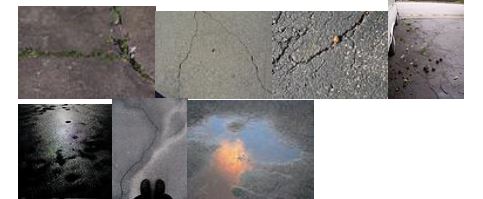it is present along with an approximate width is to be recorded in the comments section on the back of the inspection sheet. Where pavers are present in a private driveway, if an urgent uplift is encountered, the pavers are not to be painted (please refer to section 4.5.2) . If you come across a driveway that has settled and is either pavers or colored concrete then this should be noted on the inspection because these will be reassigned to Public Works Admin Inspectors by Technical Support - IMS. A service request will then be issued through the Amanda system. Furthermore, when a sidewalk runs through a residential or private driveway, inspection is only to be carried out on the portion of the driveway that lies within the width of the sidewalk (as viewed below in the right photo of Fig. 6.5),

Fig. 6.5: Brick/Stone Pavers as Part of a Sidewalk ( Google Maps - ©2013 Google)
7. SEVERITY OF DEFICIENCIES FOR ASPHALT SIDEWALKS
For asphalt sidewalks, the inspection sheets require a severity to be assigned to each noted deficiency. The following sections will show some examples of different deficiencies as a reference to determine severities.
7.1 Low Severity
Low severity deficiencies are not likely to cause injury to pedestrians and do not require repair. For example, low severity cracks are often reflective cracks that represent cracks that are beginning at the bottom of the slab and appear as a thin surface cracks. (see Figure 7.1)

Fig. 7.1: Examples of Some Low Severity Deficiencies ( www.flickr.com )
7.2 Medium Severity

